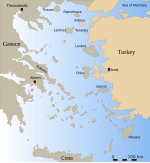Paros
Part of the Cyclades island group, it lies to the west of Naxos, from which it is separated by a channel about 8 kilometres (5 miles) wide.
The Municipality of Paros includes numerous uninhabited offshore islets totaling 196.308 square kilometres (75.795 sq mi) of land.
[5] Today, abandoned marble quarries and mines (with some still being in use) can be found on the island, but Paros is primarily known as a popular tourist spot.
The story that Paros of Parrhasia colonized the island with Arcadians[6] is an etymological fiction of the type that abounds in Greek legends.
As late as 385 BC the Parians, in conjunction with Dionysius of Syracuse, founded a colony on the Illyrian island of Pharos[2] (Hvar).
[2][13] By means of an inscription, Ludwig Ross was able to identify the site of the temple; it lies, as Herodotus suggests, on a low hill beyond the boundary of the town.
[2] Paros also sided with shahanshah Xerxes I of Persia against Greece in the second Greco-Persian War (480–479 BC), but, after the battle of Artemisium, the Parian contingent remained inactive at Kythnos as they watched the progression of events.
From the inscription of Adule, it is understood that the Cyclades, which are presumed to include Paros, were subjected to the Ptolemies, the Hellenistic dynasty (305–30 BC) that ruled Egypt.
Paros became subject to the Duchy of the Archipelago, a fiefdom made up of various Aegean islands ruled by a Venetian duke as nominal vassal of a succession of crusader states.
Under the Treaty of Constantinople (1832), Paros became part of the newly independent Kingdom of Greece, the first time the Parians had been ruled by fellow Greeks for over six centuries.
At this time, Paros became the home of a heroine of the nationalist movement, Manto Mavrogenous, who had both financed and fought in the war for independence.
In 1944, during the German occupation of Paros, the island's strategic importance led to the forced construction of an airfield located near the village of Marpissa.
[20] Local resistance, aided by the Allies, sought to sabotage the project, with Nikolas Stellas, a 23-year-old partisan, emerging as a key figure.
This resistance effort was part of a broader Allied strategy in the Aegean during World War II, contributing to the disruption of German military operations in the region.
[23] Starting in the summer of 2023, the island saw protests from locals on many beaches due to government failure to stop beach-side businesses from placing more umbrellas than permitted.
In Parikia town, houses are built and decorated in the traditional Cycladic style, with flat roofs, whitewash walls and blue-painted doors and window frames and shutters.
[24] On the north side of the island is the bay of Naoussa (Naussa, formerly Agoussa or Ausa), which provides a natural spacious harbor for boat traffic.
Another popular harbor is that of Drios on the south-east side, where the Turkish fleet used to anchor on its annual voyage through the Aegean[2] during the period of Ottoman rule over Paros (1537–1832).
The three villages of Prodromos (formerly Dragoulas), Marmara, and Marpissa (formerly Tsipidos), situated on an open plain on the eastern side of the island, and rich in remains of antiquity, probably occupy the site of an ancient town.
Around it are the ruins of a medieval castle which belonged in the late Middle Ages to the Venetian noble family of the Venieri[2] which fought a battle against the Turkish admiral Barbarossa in 1537.
Lefkes was the capital of the municipality Iria which included the villages Angyria or Ageria, Aliki, Aneratzia, Vounia, Kamari, Campos, Langada, Maltes, and Marathi.
However, the last few years, tourism presented to be a new source of income for the locals that led to the reconstruction of homes and landscaping to make it appealing as a tourist destination.
[2] The celebrated marble quarries lie on the northern side of the mountain anciently known as Marathi (afterwards Capresso), a little below a former convent of St Mina.











